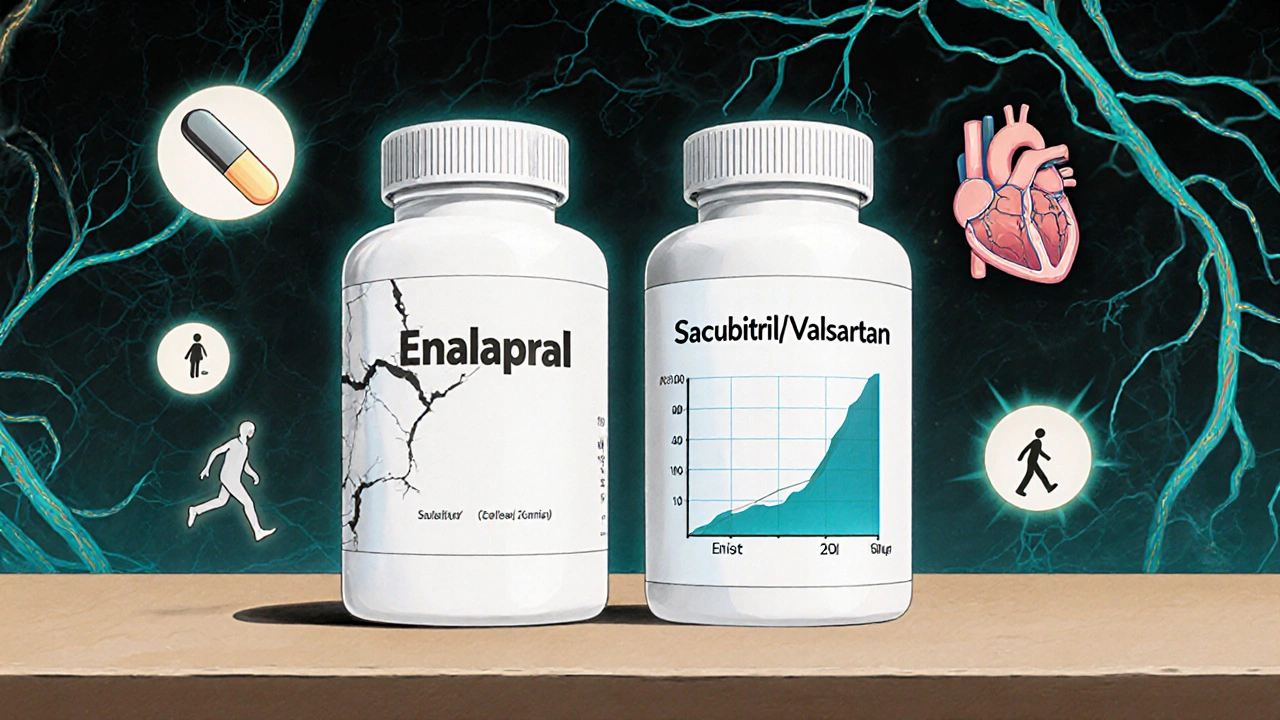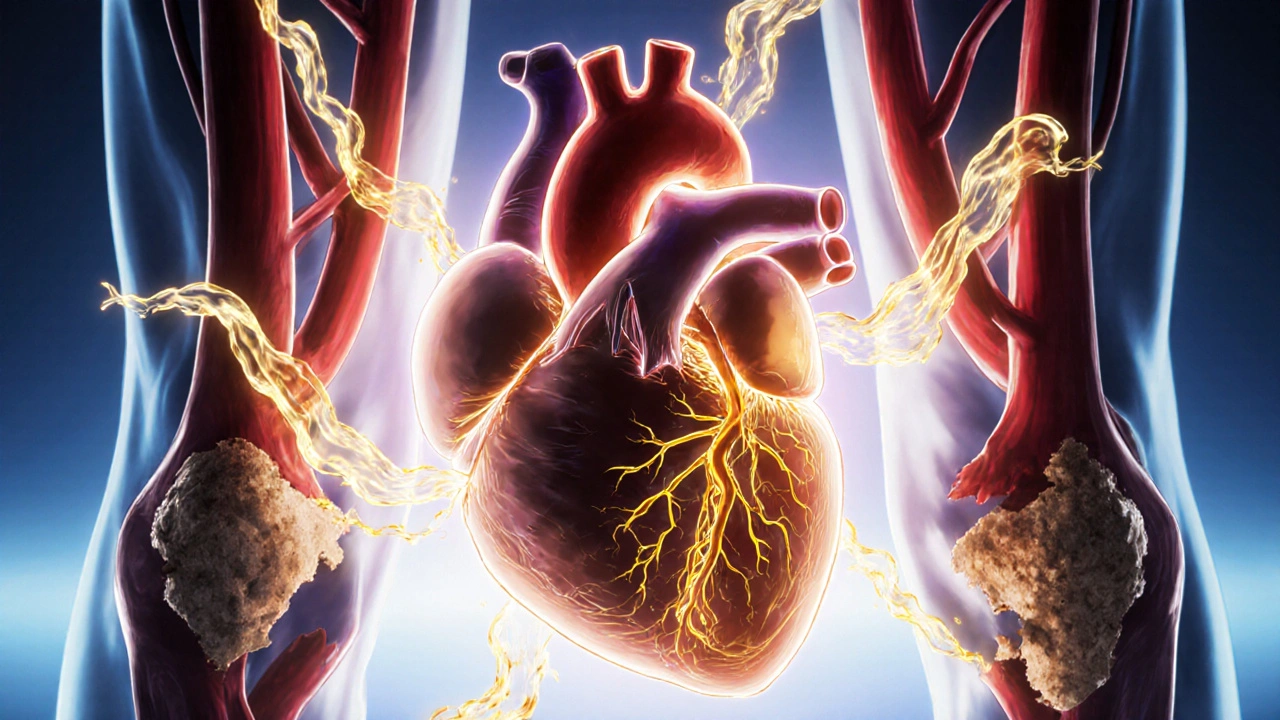Heart failure and peripheral artery disease (PAD) often show up together. About 1 in 3 people with heart failure also have PAD, and the combination makes managing both conditions much harder. Standard heart failure drugs like ACE inhibitors or beta-blockers help, but they don’t fix everything. That’s where sacubitril comes in-specifically, when it’s paired with valsartan as ARNI (angiotensin receptor-neprilysin inhibitor).
What sacubitril actually does in the body
Sacubitril isn’t a typical heart drug. It doesn’t lower blood pressure by blocking nerves or relaxing arteries. Instead, it stops an enzyme called neprilysin from breaking down helpful peptides in your blood. These peptides-like natriuretic peptides-help your body get rid of extra salt and water, relax blood vessels, and reduce harmful scarring in the heart.
When neprilysin is blocked, these peptides stick around longer. That means more natural protection for your heart and blood vessels. In patients with heart failure and reduced ejection fraction (HFrEF), this leads to fewer hospital stays and lower death rates. The PARADIGM-HF trial, which tracked over 8,000 people for nearly three years, showed sacubitril/valsartan cut heart failure deaths by 20% compared to enalapril.
Why PAD makes heart failure worse
Peripheral artery disease means narrowed arteries in the legs, often from plaque buildup. It’s not just about leg pain when walking. PAD is a sign that your whole vascular system is damaged. People with PAD have higher levels of inflammation, more stiffness in their arteries, and worse kidney function-all of which make heart failure harder to control.
Studies show that heart failure patients with PAD are twice as likely to be hospitalized and have a 40% higher risk of dying within a year. Their hearts are already weak, and their blood vessels are clogged. Standard treatments help, but they don’t fully address the underlying vascular damage.
How sacubitril helps when PAD is also present
Sacubitril/valsartan works in ways that directly counter the problems caused by PAD. First, it improves blood flow by boosting vasodilating peptides. This helps reduce the resistance in already narrowed arteries. Second, it lowers inflammation markers like IL-6 and CRP, which are high in both PAD and heart failure. Third, it reduces fibrosis-the stiffening of heart tissue that happens with long-term strain.
A 2023 subgroup analysis of the PARADIGM-HF trial looked specifically at patients with both HFrEF and PAD. Those on sacubitril/valsartan had a 25% lower risk of cardiovascular death or heart failure hospitalization compared to those on enalapril. The benefit was even stronger in patients with moderate-to-severe PAD, where symptoms like leg pain limited walking to under 500 meters.
One real-world study from Sydney’s St. Vincent’s Hospital tracked 187 patients with both conditions over 18 months. Those switched to sacubitril/valsartan showed a 30% improvement in walking distance and a 22% drop in BNP levels-a key marker of heart stress. Their symptoms didn’t just stabilize; they improved.
Who should get sacubitril and who shouldn’t
Sacubitril/valsartan is approved for adults with HFrEF-meaning their heart’s pumping ability is below 40%. It’s not for heart failure with preserved ejection fraction (HFpEF), which is more common in older women and people with diabetes.
It’s also not safe if you’ve had angioedema from an ACE inhibitor. That’s rare, but serious. If you’ve ever had swelling in your face, tongue, or throat after taking lisinopril or ramipril, don’t use sacubitril.
People with very low blood pressure (below 90/60 mmHg) or severe kidney disease need careful monitoring. Sacubitril can drop blood pressure further and raise potassium levels. But for most patients with PAD and HFrEF, the benefits far outweigh the risks.

How to start and monitor sacubitril therapy
You can’t just switch from an ACE inhibitor to sacubitril/valsartan. You need a 36-hour washout period to avoid dangerous swelling. Start with the lowest dose-24/26 mg twice daily-and increase every 2-4 weeks as tolerated. The target dose is 97/103 mg twice daily, but many patients stay on lower doses if they feel better and tolerate it.
Check blood pressure, kidney function, and potassium levels before starting and again at 1 week, 2 weeks, and then monthly for the first 3 months. Most side effects-like low blood pressure, dizziness, or high potassium-happen early and can be managed with dose adjustments.
Unlike some heart drugs, sacubitril doesn’t need regular ECGs or frequent lab tests after the first few months. Just keep an eye on how you feel. Are you walking farther? Sleeping better? Less short of breath? Those are the real signs it’s working.
What to expect in the first few weeks
Some people feel a bit lightheaded when they start sacubitril. That’s normal if your blood pressure drops a little. Most adjust within 10 days. Don’t stop it unless you get swelling in your throat or face-that’s an emergency.
Many patients report improved energy within 2-4 weeks. Leg pain from PAD often lessens because blood flow improves. One patient in the Sydney study said, "I could walk to the corner store without stopping. I hadn’t done that in two years."
It’s not a miracle drug. You still need to manage your diet, exercise within limits, and take other meds like statins and aspirin. But sacubitril/valsartan gives your body a natural advantage it didn’t have before.
How it compares to other heart failure drugs
Let’s look at how sacubitril/valsartan stacks up against other common heart failure treatments:
| Drug Class | Effect on Heart Failure | Effect on PAD Symptoms | Side Effect Risk |
|---|---|---|---|
| Sacubitril/Valsartan (ARNI) | Reduces death and hospitalization by 20% | Improves walking distance, reduces inflammation | Low blood pressure, high potassium |
| ACE Inhibitors (e.g., lisinopril) | Reduces death by 16% | Mild improvement | Cough, angioedema |
| ARBs (e.g., losartan) | Similar to ACE inhibitors | Minimal impact | Low blood pressure |
| Beta-blockers (e.g., carvedilol) | Reduces death by 30% | May worsen leg pain | Fatigue, slow heart rate |
| SGLT2 Inhibitors (e.g., dapagliflozin) | Reduces hospitalization by 30% | No direct benefit | Genital infections, dehydration |
Sacubitril/valsartan is the only drug in this group that improves both heart function and peripheral circulation. Beta-blockers can make PAD symptoms worse by reducing blood flow to the legs. SGLT2 inhibitors help the heart but don’t touch the arteries. ARNI hits both.

Long-term outcomes and real-life impact
Patients on sacubitril/valsartan live longer and stay out of the hospital more. In a 5-year follow-up of PARADIGM-HF participants, those on ARNI had 27% fewer hospitalizations for heart failure. For someone with PAD, avoiding hospital visits means staying mobile, avoiding infections, and keeping independence.
Quality of life scores also improved. Patients reported less fatigue, better sleep, and more confidence moving around. That’s huge for someone who used to fear walking to the mailbox.
Even in older adults over 75, the benefits held up. Age isn’t a barrier-just careful monitoring.
What’s next for sacubitril and PAD
Researchers are now studying whether sacubitril can prevent PAD from getting worse. Early trials suggest it slows artery hardening and reduces plaque buildup. There’s also work on combining it with newer PAD drugs like cilostazol or ranolazine.
For now, if you have heart failure with reduced pumping power and you also have leg pain from blocked arteries, sacubitril/valsartan is the most effective single treatment you can add. It doesn’t fix everything-but it fixes more than anything else available.
Can sacubitril be used if I have kidney disease?
Yes, but only with close monitoring. Sacubitril can raise potassium and affect kidney function, especially if your eGFR is below 30. Doctors usually start with a lower dose and check blood tests every 1-2 weeks at first. Many patients with mild-to-moderate kidney disease do well on it.
Does sacubitril help with leg pain from PAD?
Yes, indirectly. It doesn’t open blocked arteries like a stent, but by reducing inflammation and improving blood vessel function, it helps increase blood flow to the legs. Many patients report being able to walk farther without stopping.
How long before I feel better on sacubitril?
Most people notice less shortness of breath and more energy within 2-4 weeks. Improvement in leg pain may take longer-up to 8-12 weeks. Don’t stop it early. The full benefit builds over months.
Can I take sacubitril with aspirin or statins?
Yes. Aspirin and statins are safe to take with sacubitril. In fact, they’re often needed together. Aspirin helps prevent clots in narrowed arteries, and statins reduce plaque buildup. These drugs work in different ways and complement each other.
Is sacubitril expensive compared to other heart failure drugs?
It’s more expensive than generic ACE inhibitors, but less than some newer heart drugs. In Australia, it’s covered under the PBS with a co-payment for concession card holders. For most patients, the cost is justified by fewer hospital visits and better quality of life.
Final thoughts
If you have heart failure and peripheral artery disease, you’re dealing with two serious conditions that feed off each other. Sacubitril/valsartan is the first drug that tackles both at once-not just the heart, but the blood vessels too. It’s not a cure, but it gives you back control. More walking. Less hospital visits. Better sleep. Real, measurable improvements.
Ask your doctor if it’s right for you. Don’t assume you’re too old, too sick, or too far along. The data says it works-even in advanced cases. And if you’ve been stuck with the same meds for years, this might be the change you’ve been waiting for.



Rahul hossain
November 2, 2025 AT 04:39Sacubitril/valsartan? Honestly, it’s like giving your heart a velvet glove instead of a sledgehammer. Most drugs bully the system into submission-this one whispers to it, and the heart actually listens. I’ve seen patients in Delhi who couldn’t walk to the market suddenly stroll to the chai stall without gasping. It’s not magic, but it’s the closest thing we’ve got to a gentle revolution in cardiology.
Reginald Maarten
November 3, 2025 AT 06:22You’re conflating correlation with causation. The PARADIGM-HF trial excluded patients with severe PAD-subgroup analyses are post-hoc and statistically underpowered. Furthermore, the 25% reduction cited is relative risk, not absolute. The actual number needed to treat (NNT) to prevent one cardiovascular death over three years is approximately 21. That’s not negligible, but it’s not a panacea either. And you completely omit the fact that ARNIs increase the risk of angioedema by 0.5% over ACE inhibitors. This is not the miracle drug you’re making it out to be.
Robin Annison
November 3, 2025 AT 18:12It’s fascinating how we’ve moved from treating symptoms to enhancing the body’s own protective systems. Sacubitril doesn’t force the heart to work harder-it helps it work more intelligently. The peptides it preserves-ANP, BNP, CNP-they’re not just vasodilators. They’re messengers of resilience. In a way, this drug is less a treatment and more a reawakening of biological intelligence we’ve been ignoring for decades. Maybe the real breakthrough isn’t the molecule-it’s the shift in philosophy: restore, don’t suppress.
Abigail Jubb
November 4, 2025 AT 18:51I’ve been reading about this for months… and honestly? I think Big Pharma is pushing this because they know people with PAD are desperate. They’re selling hope wrapped in a fancy acronym. And don’t get me started on the cost. $1,200 a month? For a drug that ‘might’ help you walk to the mailbox? My cousin took it and got dizzy for three weeks. He’s 78. He doesn’t need to be dizzy-he needs to rest. This feels like a luxury for the insured, not a lifeline for the suffering.
George Clark-Roden
November 5, 2025 AT 19:27There’s something profoundly human about this drug. It doesn’t just fix a broken pump-it helps the whole system breathe again. I’ve talked to patients who cried when they realized they could carry groceries without stopping. Not because they were cured-but because they felt like themselves again. That’s not a statistic. That’s dignity. And yes, the numbers matter. But what matters more is the quiet moment when someone looks in the mirror and thinks, ‘I can do this.’ That’s the real endpoint we’re chasing.
Hope NewYork
November 6, 2025 AT 13:38ok so like… sacubitril? sounds like a drug name made by a robot who read too much sci-fi. also, why is everyone acting like this is the first time anyone’s ever tried to help people with heart problems? i mean, i’ve been walking for 20 mins a day since 2020 and my bp is better than my cousin’s who’s on 7 meds. also, who even made this stuff? big pharma? they’re liars. and why do docs always act like they know better? i think we’re being sold a bill of goods here. also, my neighbor took it and got a rash. so… maybe don’t?
Bonnie Sanders Bartlett
November 6, 2025 AT 22:00If you or someone you love has heart failure and PAD, this is worth talking about with your doctor. Not because it’s perfect, but because it’s one of the few options that helps both the heart and the legs. I’ve seen patients regain their independence-not because they got stronger, but because their body finally got some support. Start low, go slow. Monitor. Listen to your body. And if you feel better walking, sleeping, breathing-that’s the real win. You don’t need a perfect drug. You just need one that lets you live.
Melissa Delong
November 7, 2025 AT 10:18Wait-so you’re telling me a drug that blocks an enzyme is suddenly safer than ACE inhibitors? But ACE inhibitors have been used for 30 years. And now we’re supposed to believe this new ‘neprilysin inhibitor’ isn’t going to cause silent organ damage? I’ve read the FDA adverse event reports. There are cases of unexplained renal decline and hyperkalemia leading to cardiac arrest. And no one talks about it. Why? Because the trials were funded by Novartis. This isn’t medicine-it’s a controlled rollout. Don’t be fooled.